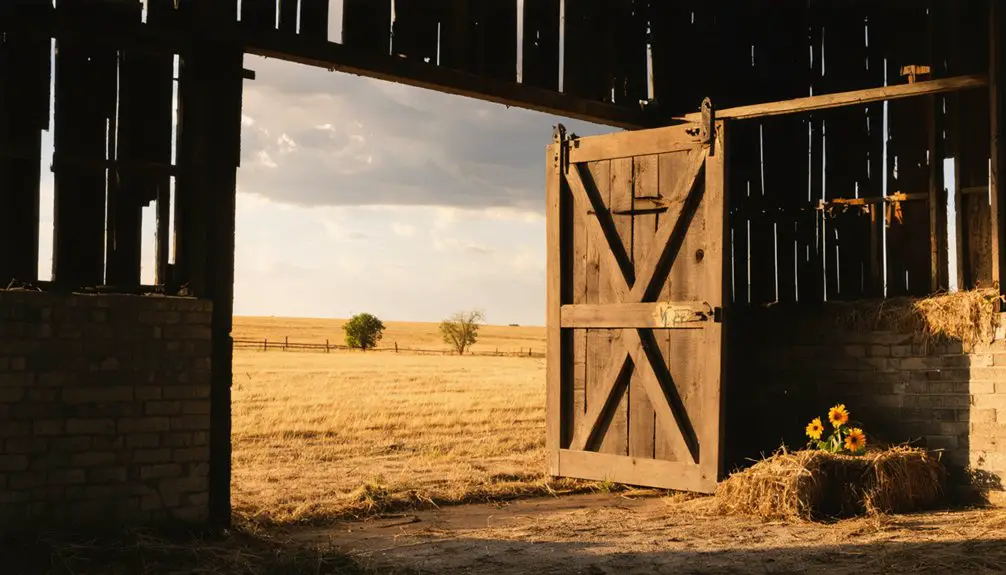You’ll find Abram’s ghost town roots in Lincoln County, Kansas, where it served as the first county seat from 1870-1872. Myron Greene established the town on elevated ridge land, building a general store that doubled as a post office and community center. After losing a controversial county seat election to Lincoln Center by 232-176 votes, Abram’s residents abandoned the settlement. The town’s brief but significant role in Kansas frontier life holds untold stories of political intrigue and pioneer spirit.
Key Takeaways
- Abram was Kansas’s first Lincoln County seat in 1870, established on elevated terrain with a courthouse, general store, and post office.
- Myron Greene developed Abram by purchasing land from Union Pacific Railroad, dividing it into 36 blocks with public spaces.
- Greene’s Store served as the town’s primary gathering place, hosting government offices, commerce, and community meetings.
- The town rapidly declined after losing the county seat to Lincoln Center in an 1872 election marked by controversy.
- Abram is now a ghost town marked only by a memorial, though it historically supported Danish Lutheran settlers until 1920.
The Birth of Lincoln County’s First County Seat
Although Lincoln County was created in 1867, it remained unorganized until 1870 when residents held their first elections.
Lincoln County existed on paper for three years before residents organized and held their first elections in 1870.
As political rivalries emerged during the early stages of community organization, Governor James Harvey stepped in to establish a temporary county seat in Marion Township near present-day Lincoln.
You’ll find that the county’s first official seat wasn’t destined to stay there long.
In January 1871, voters chose to move the county seat to Abram, located three miles east of the governor’s designated site.
The Abram Town Company, keen to cement their position, donated lots for a courthouse. The community grew quickly with O.N. Greene overseeing the construction of new town buildings throughout the site. The intense rivalry between Abram and Lincoln ultimately ended with Lincoln prevailing, forcing Abram’s buildings to be relocated.
Early Political Landscape and Town Development
While Abram’s selection as county seat marked a pivotal moment, the town’s political landscape took shape through the efforts of key individuals and strategic development.
You’ll find that Myron Greene led the charge, constructing a prominent 1.5-story building that became central to community governance. Under O.N. Greene’s supervision, the town quickly established core institutions including a general store and post office. Similar to towns like Bell Plane Town Company, the founders strategically purchased land to establish the settlement. Like the Trading Post settlement in Kansas, the area had deep historical roots dating back to early frontier times.
The political dynamics of Abram centered around its courthouse, purposefully positioned on the highest ridge.
You can trace the town’s brief reign as county seat through two pivotal elections – its victory in January 1871 and subsequent loss to Lincoln Center in February 1872, when 232 voters opposed Abram’s 176.
These electoral decisions ultimately shaped the town’s destiny.
Strategic Location and Geographic Features
Situated atop a distinctive ridge that sloped in all directions, Abram’s strategic location offered natural elevation advantages that shaped its early development.
Perched high on an all-directional sloping ridge, Abram’s elevated position provided key strategic benefits during its founding years.
You’ll find the courthouse was purposefully built at the ridge’s highest point, maximizing visibility while providing natural drainage and defense benefits.
The town’s geographic advantages included its position three miles east of the temporary county seat, with proximity to Rocky Hill and the tree-lined Saline River.
Similar to how the Missouri River transformed Doniphan’s landscape, settlement patterns developed around nearby water sources like Beaver Creek, though Abram lacked direct access to major navigable waterways.
Like many Lincoln County sites across America, the geographic positioning played a crucial role in its development potential.
The site’s integration with transportation routes, including Union Pacific Railroad land holdings, initially supported the town’s growth.
Despite these favorable conditions, Abram’s location ultimately couldn’t sustain its status as county seat against competition from Lincoln Center.
Myron Greene’s Pioneering Vision
In January 1871, Myron Greene purchased a quarter section of Union Pacific Railroad land to establish the town of Abram, envisioning it as Lincoln County’s permanent seat of government.
Greene’s vision centered on creating a well-planned community, as he’d the land surveyed into 36 blocks with a public square and designated spaces for multiple churches. Church services for all denominations were held in the second story of his store.
You’ll find that his pioneering spirit manifested in the town’s first building – a multipurpose structure that housed a general store, post office, and county offices.
His commitment to community development extended beyond commerce, with O.N. Greene supervising all construction to guarantee quality standards.
The town quickly grew to include essential services like a hotel, blacksmith shop, newspaper office, and community well, transforming Greene’s dream into a functioning frontier settlement. Following disputes among settlers and a vote in 1872, the county seat was relocated to Lincoln Center, leading to Abram’s eventual decline.
The Heart of Community Life
You’d find the bustling heart of Abram’s community life centered at Greene’s Store, where residents gathered to collect mail and purchase supplies from the newly established post office in February 1872.
The building’s ground floor served dual purposes as both general store and post office, creating a natural meeting point for daily interactions and news exchange. This location proved significant but short-lived, as the post office was moved away in late 1872.
The upper floor’s public hall hosted frequent community meetings and social gatherings, cementing the building’s role as the town’s primary social hub. Like many Kansas towns of the era, including Cedar Point’s bank, this establishment served as a cornerstone of local commerce and social activity.
Gathering at Greene’s Store
As Abram’s first building and most prominent gathering place, Greene’s Store stood as a tribute to frontier ingenuity and community spirit.
The one-and-a-half story structure housed essential services on its first floor, where you’d find the general store and post office handling your daily needs and mail delivery three times a week.
You’d discover the true heart of Abram’s social life upstairs, where community gatherings flourished in the spacious upper story.
Whether you needed to attend a church service, participate in town meetings, or send your children to the area’s first school sessions, Greene’s Store provided the space.
This multi-purpose venue fostered social cohesion until the county seat’s relocation in late 1872, when Abram’s prominence began to fade.
Public Hall Above Ground
The grand hall above Greene’s Store served as Abram’s vibrant social center, stretching an impressive 25 by 60 feet across the building’s upper level.
As you’d explore this one-and-a-half story structure, you’d find a public hall that became the heartbeat of community gatherings in early Kansas settlement life.
- Hosted critical town meetings and legal proceedings
- Provided space for annual festivals and social celebrations
- Served as a central meeting point for community decisions
- Functioned as a venue for addressing local conflicts
- Represented the town’s commitment to shared public spaces
The hall’s simple yet functional design reflected the practical needs of frontier life, offering a gathering place where you could participate in shaping the community’s future through various social and administrative activities.
Post Office Hub Activities
When Abram’s post office opened its doors in February 1872, it quickly became the heart of community life within Greene’s Store building.
You’d find this strategic hub positioned on a ridge, serving as the primary center for community communication throughout Lincoln County. The post office’s significance extended beyond mail services – it facilitated essential business transactions and kept residents connected to the outside world.
As you’d explore the building, you’d discover a bustling general store on the main level, while the upper floor hosted various community gatherings and social events.
However, this vibrant period proved short-lived. When Abram lost its county seat status in December 1872, the post office operations shifted back to Rocky Hill, marking the beginning of the town’s decline.
Power Shift: The 1872 County Seat Election

During 1872, Kansas county seat elections triggered widespread controversy and legal battles across multiple regions, reflecting the period’s intense competition between emerging towns.
You’ll find these elections weren’t just about political influence – they determined which communities would thrive as administrative centers.
- Voter fraud allegations frequently led to court challenges and invalidated results
- Growing towns near county centers emerged as strong county seat contenders
- Population shifts could quickly turn the tide against established locations
- Local companies wielded significant power in organizing new town developments
- Multiple elections often occurred within months due to legal disputes
The stakes were high as towns vied for county seat status, knowing it would secure their future prosperity.
Court rulings could swiftly change election outcomes, forcing administrative functions to relocate and reshape local power dynamics.
From Administrative Hub to Abandoned Settlement
You’ll find that Abram’s decline began immediately after Lincoln Center won the county seat election by a 232-176 vote in February 1872.
The transfer of administrative functions happened swiftly, with county offices, records, and the post office relocating to the new location.
The exodus of government operations stripped Abram of its primary purpose, leading to the rapid departure of residents and businesses until the town was completely abandoned.
Political Power Shift
Shortly after Lincoln County’s creation in 1867, Abram emerged as its first designated county seat, marking the town’s brief reign as a political hub.
Political maneuvering and community competition intensified as Lincoln County’s organization took shape in 1870. You’ll find that Abram’s strategic position on a ridgeline, with its courthouse at the highest point, initially gave it an advantage in the power struggle.
- Temporary county seat began in Marion Township
- Abram secured county seat status in 1871 election
- Town company granted deeds for courthouse lots
- First building served multiple governmental functions
- Post office established central administration point
Rapid Town Exodus
Abram’s fortunes changed dramatically after the February 19, 1872 county seat election, where Lincoln Center won by a decisive margin of 232 to 176 votes.
You would’ve witnessed a swift town migration as government offices, businesses, and residents abandoned their ridge-top settlement for opportunities in Lincoln Center, just three miles east.
The community decline was severe and irreversible. Without the county seat’s administrative functions, Abram’s commercial activities plummeted.
The once-bustling general store and post office, which had served as crucial gathering spaces, fell silent. The town’s basic infrastructure couldn’t sustain alternative industries, and its strategic hilltop location no longer offered meaningful advantages.
Even the brief boost from Rocky Hill’s post office relocation couldn’t stem the exodus, and Abram quickly transformed from a promising hub into an abandoned ghost town.
Legacy in Lincoln County History

While Lincoln County’s early development was marked by numerous settlements, few places left as profound an impact on the region’s history as the ghost town of Abram.
You’ll find its cultural influences and community resilience reflected in the foundations of Lincoln County’s governance and social fabric.
- Served as the county’s first seat of government in 1870
- Hosted diverse religious services in Greene’s store, welcoming all denominations
- Supported Danish Lutheran settlers, preserving their heritage until 1920
- Contributed to the county’s pioneer spirit during Indian raids and settlement challenges
- Left a lasting mark through historical documentation and a 1930s memorial marker
Despite its eventual decline, Abram’s role in establishing early governmental structures and fostering religious diversity helped shape Lincoln County’s character during its formative years.
Extinct Towns of the Kansas Frontier
The story of Kansas frontier towns echoes Abram’s own narrative, with countless settlements rising and falling across the state’s vast landscape during the 19th century.
You’ll find these towns emerged along rivers, trails, and railroads, often starting as trading posts or military outposts where settlers faced frontier challenges like harsh weather and economic instability.
Many towns vanished when railroads changed routes or natural resources dried up.
Today, you can discover their remnants through abandoned buildings, old cemeteries, and former post office locations.
Ghost town preservation efforts help protect significant sites like Nicodemus, a historic black pioneer settlement, and Quindaro, a Free-State town.
These extinct communities tell powerful stories of freedom, diversity, and the determined spirit of Kansas settlers who shaped the state’s development.
Frequently Asked Questions
What Happened to the Original Residents of Abram After Its Abandonment?
You’ll find most residents moved to Lincoln Center after the 1872 county seat loss, with relocation impacts spreading families across Lincoln County, though their community legacy lived on through regional development.
Were There Any Notable Crimes or Conflicts During Abram’s Brief Existence?
You won’t find any notable crime history in Abram’s records. The town’s main conflicts centered on peaceful county seat elections, with established conflict resolution processes handling political disputes through voting.
How Much Did Land and Buildings Cost in Abram in 1871?
Like early pioneers chasing Manifest Destiny, you’d find land prices were remarkably cheap through the Homestead Act – about $18 for 160 acres, while building costs remain unknown for Abram’s frontier structures.
What Native American Tribes Previously Inhabited the Abram Town Area?
You’ll find the Potawatomi tribe dominated this area’s tribal history, with Chief Abram Burnett’s leadership leaving a lasting cultural impact. The Bodéwadmi, Kansa, Osage, and Comanche tribes also traversed these lands.
Did Any Significant Weather Events or Natural Disasters Affect Abram?
Like a blank canvas untouched by nature’s fury, you won’t find records of tornado damage or drought impact striking Abram. Its ridge location likely shielded it from severe weather events.
References
- https://legendsofkansas.com/abram-kansas/
- https://www.youtube.com/watch?v=5AmcGumPdNQ
- https://www.legendsofamerica.com/doniphan-kansas/
- https://www.youtube.com/watch?v=OyBXD18P_j4
- https://legendsofkansas.com/lincoln-county-extinct-towns/
- https://fhsuguides.fhsu.edu/kansasheritage/lincolncounty
- https://www.kancoll.org/books/cutler/lincoln/lincoln-co-p1.html
- https://www.kancoll.org/khq/1937/37_2_ksnotes.htm
- https://freepages.rootsweb.com/~lincolncounty/genealogy/rockyhill1955.htm
- https://octa-trails.org/wp-content/uploads/2023/05/Ellis-Uniontown-and-Plowboy–-Potawatomi-Ghost-Towns.pdf



